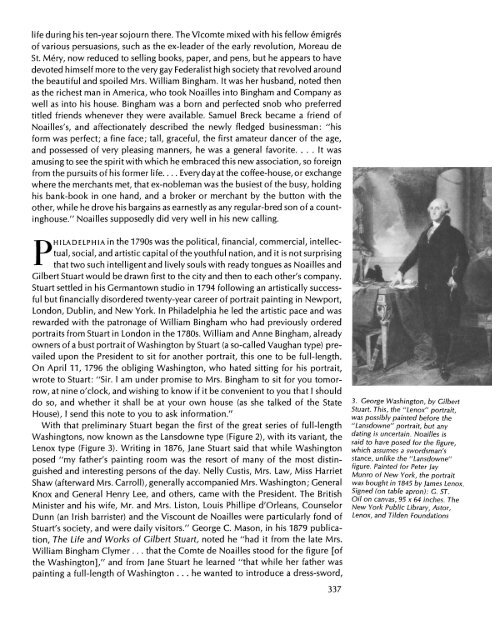The Metropolitan Museum of Art Bulletin, v. 29, no. 7 (March, 1971)
The Metropolitan Museum of Art Bulletin, v. 29, no. 7 (March, 1971)
The Metropolitan Museum of Art Bulletin, v. 29, no. 7 (March, 1971)
You also want an ePaper? Increase the reach of your titles
YUMPU automatically turns print PDFs into web optimized ePapers that Google loves.
life during his ten-year sojourn there. <strong>The</strong> Vicomte mixed with his fellow emigres<br />
<strong>of</strong> various persuasions, such as the ex-leader <strong>of</strong> the early revolution, Moreau de<br />
St. Mery, <strong>no</strong>w reduced to selling books, paper, and pens, but he appears to have<br />
devoted himself more to the very gay Federalist high society that revolved around<br />
the beautiful and spoiled Mrs. William Bingham. It was her husband, <strong>no</strong>ted then<br />
as the richest man in America, who took Noailles into Bingham and Company as<br />
well as into his house. Bingham was a born and perfected s<strong>no</strong>b who preferred<br />
titled friends whenever they were available. Samuel Breck became a friend <strong>of</strong><br />
Noailles's, and affectionately described the newly fledged businessman: "his<br />
form was perfect; a fine face; tall, graceful, the first amateur dancer <strong>of</strong> the age,<br />
and possessed <strong>of</strong> very pleasing manners, he was a general favorite.... It was<br />
amusing to see the spirit with which he embraced this new association, so foreign<br />
from the pursuits <strong>of</strong> his former life.... Everyday at the c<strong>of</strong>fee-house, or exchange<br />
where the merchants met, that ex-<strong>no</strong>bleman was the busiest <strong>of</strong> the busy, holding<br />
his bank-book in one hand, and a broker or merchant by the button with the<br />
other, while he drove his bargains as earnestly as any regular-bred son <strong>of</strong> a countinghouse."<br />
Noailles supposedly did very well in his new calling.<br />
IA in the 1790s was the political, financial, commercial, intellec-<br />
HI LADELPH<br />
tual, social, and artistic capital <strong>of</strong> the youthful nation, and it is <strong>no</strong>t surprising<br />
that two such intelligent and lively souls with ready tongues as Noailles and<br />
Gilbert Stuart would be drawn first to the city and then to each other's company.<br />
Stuart settled in his Germantown studio in 1794 following an artistically successful<br />
but financially disordered twenty-year career <strong>of</strong> portrait painting in Newport,<br />
London, Dublin, and New York. In Philadelphia he led the artistic pace and was<br />
rewarded with the patronage <strong>of</strong> William Bingham who had previously ordered<br />
portraits from Stuart in London in the 1780s. William and Anne Bingham, already<br />
owners <strong>of</strong> a bust portrait <strong>of</strong> Washington by Stuart (a so-called Vaughan type) prevailed<br />
upon the President to sit for a<strong>no</strong>ther portrait, this one to be full-length.<br />
On April 11, 1796 the obliging Washington, who hated sitting for his portrait,<br />
wrote to Stuart: "Sir. I am under promise to Mrs. Bingham to sit for you tomorrow,<br />
at nine o'clock, and wishing to k<strong>no</strong>w if it be convenient to you that I should<br />
do so, and whether it shall be at your own house (as she talked <strong>of</strong> the State<br />
House), I send this <strong>no</strong>te to you to ask information."<br />
With that preliminary Stuart began the first <strong>of</strong> the great series <strong>of</strong> full-length<br />
Washingtons, <strong>no</strong>w k<strong>no</strong>wn as the Lansdowne type (Figure 2), with its variant, the<br />
Le<strong>no</strong>x type (Figure 3). Writing in 1876, Jane Stuart said that while Washington<br />
posed "my father's painting room was the resort <strong>of</strong> many <strong>of</strong> the most distinguished<br />
and interesting persons <strong>of</strong> the day. Nelly Custis, Mrs. Law, Miss Harriet<br />
Shaw (afterward Mrs. Carroll), generally accompanied Mrs. Washington; General<br />
K<strong>no</strong>x and General Henry Lee, and others, came with the President. <strong>The</strong> British<br />
Minister and his wife, Mr. and Mrs. Liston, Louis Phillipe d'Orleans, Counselor<br />
Dunn (an Irish barrister) and the Viscount de Noailles were particularly fond <strong>of</strong><br />
Stuart's society, and were daily visitors." George C. Mason, in his 1879 publication,<br />
<strong>The</strong> Life and Works <strong>of</strong> Gilbert Stuart, <strong>no</strong>ted he "had it from the late Mrs.<br />
William Bingham Clymer... that the Comte de Noailles stood for the figure [<strong>of</strong><br />
the Washington]," and from Jane Stuart he learned "that while her father was<br />
painting a full-length <strong>of</strong> Washington ... he wanted to introduce a dress-sword,<br />
337<br />
3. George Washington, by Gilbert<br />
Stuart. This, the "Le<strong>no</strong>x" portrait,<br />
was possibly painted before the<br />
"Lansdowne" portrait, but any<br />
dating is uncertain. Noailles is<br />
said to have posed for the figure,<br />
which assumes a swordsman's<br />
stance, unlike the "Lansdowne"<br />
figure. Painted for Peter lay<br />
Munro <strong>of</strong> New York, the portrait<br />
was bought in 1845 by James Le<strong>no</strong>x.<br />
Signed (on table apron): G. ST.<br />
Oil on canvas, 95 x 64 inches. <strong>The</strong><br />
New York Public Library, Astor,<br />
Le<strong>no</strong>x, and Tilden Foundations

















